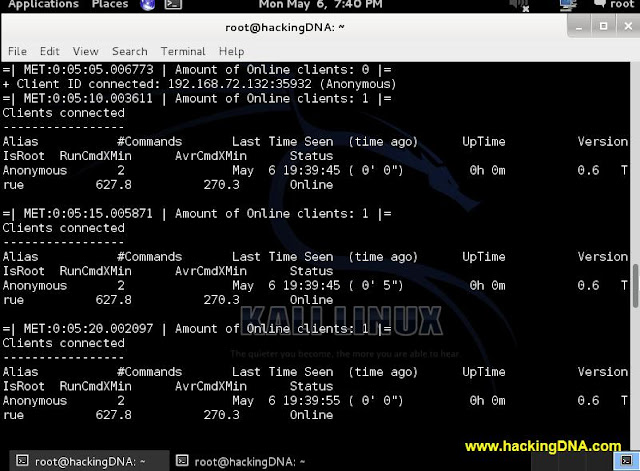INTRODUCTION
- Dnmap is a framework which follows a client/server architecture.
- The server issues nmap commands to the clients and the clients execute it.
- In this way, the load of performing such a large scan is distributed among the clients.
- The commands that the server gives to its clients are put in a command file.
- The results are stored in a log file which are saved on both the server and the client.
FEATURES OF DNMAP SERVER
- If the server gets down, clients continue trying to connect until the server gets back online.
- If
the server gets down, when you put it up again it will send commands
starting from the last command given before the shutdown. You do not
need to remember where it was.
- You can add new commands to the original file without having to stop the server. The server will read them automatically.
- If some client goes down, the server will remember which command it was executing and it will re-schedule it for later.
- It will store every detail of the operations in a log file.
- It shows real time statistics about the operation of each client, including:
- Number of commands executed
- Last time seen
- Uptime
- Version of the client
- If the client is being run as root or not.
- It calculates the amount of commands executed per minute
- The historic average of the amount of commands executed per minute
- The status of the client (Online, Offline, Executing or Storing)
- You can choose which port to use. Defaults to 46001
- Only the Online clients are shown in the running stats.
FEATURES OF DNMAP CLIENT
- If the server gets down, it keeps connecting to it until it gets up again.
- Strip strange characters from the command sent by the server. Tries to avoid command injection vulns.
- It
only executes the nmap command. It deletes the command send by the
server and changes it by the known and trusted nmap binary on the
system.
- You can select an alias for your user.
- You can change which port the client connects to.
- If
the command sent by the server does not have a -oA option, the client
add it anyway to the command, so it will always have a local copy of the
output.
- If the server sends a min-rate parameter, it is striped out.
- You can control the nmap scanning rate regarthless of servers sent parameters.
- Tell the server if you are root or not, so it can change the nmap commands accordingly.
CREATE TEXT FILE
- To create text file use this vim editor .
- Command syntax : vim <file name >
- Command used : vim commands.txt
Once you press enter , it will open your file in vim editor .
ENTER NMAP COMMANDS ON COMMAND FILE
- In this example , i simply enter two nmap commands .
- See the below image for more details -
NOW OPEN DNMAP_SERVER
- To open Dnmap_server goto > Applications > Kali Linux > Information Gathering > Network Scanners >dnmap-server
- See the below image for more help -
DNMAP SERVER OPENED
RUNNING DNMAP_SERVER
- To run dnmap_server use the command as shown below -
- Command Used : /usr/bin/dnmap_server -f commands.txt
- See the below image for more details -
OPEN DNS_CLIENT
- To open Dnmap_client goto Kali Linux > Information Gathering > Network Scanners >dnmap-client .
- See the below image for more details -
RUNNING DNMAP CLIENT
- To run dnmap_client , use the following command .
- Command syntax : /usr/bin/dnmap_client -s <server-ip>
- Example : /usr/bin/dnmap_client -s 192.168.72.132
Note : Here server ip is your Kali linux ip address .
DNMAP_SERVER RESPONSE
- Now you can see that clients are connected and response are showing on the dnmap_server .
- See the below image for more details -

DNMAP OUTPUT
- So here is your output files inside the nmap_output folder which is automatically created
- See the below image for more details -
- This is how we can use this network scanner tool .
- Soon more examples will be uploaded soon.
|









Comments